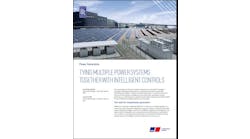Siemens to Assist Santa Fe Community College with New Microgrid Training Center
In partnership with Siemens, Santa Fe Community College plans to build a microgrid training center, partially funded through a $351,000 grant from the U.S. Economic Development Administration (EDA).
The Building Energy Automation and Microgrid Training Center (BEAMTC) will focus on product development, testing and workforce training. It is expected to attract jobs and businesses to the Santa Fe, New Mexico region and position engineering students for employment in the rapidly growing microgrid industry.
“The EDA grant will put the college on the world stage for innovation, but more importantly it will be training a regional workforce for skills that are in high demand,” said SFCC president Randy Grissom.
The college is leveraging an additional $326,000 in state appropriations, and $111,661 in donated equipment and engineering expertise from Siemens and other industry partners to support this project.
“We’re fortunate to be partnering with EDA and Siemens Industries to make BEAMTC a reality. Siemens has committed to corporate carbon neutrality by 2030,” Grissom said. “Siemens is the world’s most recognized name in advanced microgrids. Siemens is investing sustainably in the advancement of science education in order to prepare students for the rapidly expanding career opportunities in these fields. The combination of technological fit and educational mission makes Siemens an ideal partner for BEAMTC.”
The microgrid will expand the reach of the building automation system so that it can integrate multiple energy systems, add resiliency to the grid in the event of power disruptions, optimize the energy systems and enable advanced cybersecurity.
BEAMTC will be housed in the college’s Trades and Advanced Technology Center and will serve the entire North Central New Mexico Economic Development District, which encompasses seven counties (Colfax, Los Alamos, Mora, Rio Arriba, San Miguel, Santa Fe and Taos) as well as nine pueblos and tribes.
The college will install equipment in an existing lab to accommodate the BAS equipment. In addition, the college is building an almost 12,000 square foot four-bay gutter connected greenhouse and a second lab that will host Siemens advanced microgrid controller.
The center will incorporate building energy management techniques as a component of smart energy systems design, and develop these principles in a nanogrid serving the new greenhouse complex for advanced hydroponics and aquaponics. Both the building automation systems lab and the greenhouse nanogrid will become nodes of the proposed campus-wide microgrid, which is currently in development.
U.S. Congressman Ben Ray Luján foresees the training center making Santa Fe Community College a statewide leader in building a green energy workforce and economy.
“This grant recognizes their smart, forward-looking approach to ensure that students graduate with the skills to get good jobs in the renewable energy sector,” Luján said.
Track news about the Santa Fe Community College microgrid training center as the project develops. Subscribe to the Microgrid Knowledge newsletter. It’s free.






